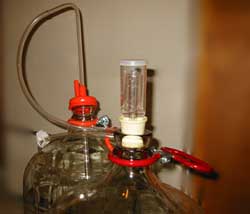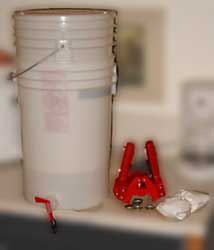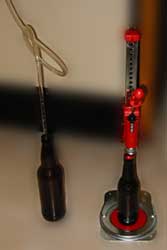Like most hobbies, or trades, brewing has a whole set of unique equipment. Homebrewer’s equipment and professional brewer’s equipment differ significantly, but the ideas are generally the same.
Lets separate the equipment into these categories:
Boiling, Measuring, Fermenting, Bottling, or Kegging, and …. enjoying!
Boiling:
 This is a brew kettle sitting on our electric range. Use gas if you can
This is a brew kettle sitting on our electric range. Use gas if you can
Here is what is shown. Grain Bag (left), Strainer, Thermometer, Hop Sack, and a Big Ol’ Spoon. Did I mention the 20+ quart stock pot. Stainless Steel is best, but more expensive.
Thermometers are great for when you start using partial mash, or all-grain brews.
A plastic Spoon is better than wood because it has wood has pores that harbor little microbes. Microbes are bad.
Like I said before, gas stoves are better because they tend not to scorch the wort like an electric element does.
Measurement:
 Since brewing is basically chemistry (or cooking), precision measurement is a must. If you want to get the same results over and over, you must be able to duplicate a recipe.
Since brewing is basically chemistry (or cooking), precision measurement is a must. If you want to get the same results over and over, you must be able to duplicate a recipe.
These are some common measuring devises used by home brewers. A Hydrometer, a cylindrical measuring vessel, a turkey baster, and a scale.
A hydrometer is important for determining the specific gravity of your wort. You can determine if fermentation is done by watching for when the SG no longer changes. You also determine the %ABV (percent alcohol by volume) of your beer by using specific gravity.
The cylinder and the baster go together. Sanitize the baster, suck some beer from the wort, and squirt it into the cylinder. Now you can take a gravity reading of the wort with minimal exposure of your wort.
The scale is for measuring hops, grains, or adjuncts. Hops are usually weighed in ounces, grain in pounds, and adjuncts in both.
Fermenting:
 Fermentation requires a clean environment where yeast turns sugars into alcohol & carbon dioxide.
Fermentation requires a clean environment where yeast turns sugars into alcohol & carbon dioxide.
Fermentation uses a carboy, a gas lock, stoppers, and siphon line. A thermometer is also helpful.
Carboys can be either glass or plastic, but glass is preferred. Glass is clear, so you can see the fermentation in action, and doesn’t leak air into the vessel.
A gas lock and stopper go in the mouth of the carboy to keep bad air out and let carbon dioxide out. The lock is filled with sterile water so only air may pass out.
A siphon system is used to transfer the beer or what have you between vessels. These tubes will help move the wort from primary to secondary fermentation, and finally to bottling.
A nice addition is a fermometer. The image below shows this modified aquarium stick on thermometer for carboys.

Bottling:
 Bottling is exciting because it means you’re almost ready to drink the beer. Only 2 more weeks!
Bottling is exciting because it means you’re almost ready to drink the beer. Only 2 more weeks!
Bottling requires (besides the utmost in sanitation): A bottling or racking bucket, a racking cane, cleaned and sanitized bottles & caps (pop top, not twisty), a capper, and priming sugar.
A racking bucket has a spigot at the bottom. Siphon the beer from the ferment into the bucket and cover it up. Any exposure of your beer could result in a lot of work and some nasty beer. After you siphon the beer in, you want to add the priming sugar. This is usually 3/4 cup corn sugar (dextrose), and it should be dissolved into 2 cups of boiled water. Mix the solution in thoroughly.
A racking cane is attached to the spigot. A racking cane has a spring in it that keeps it closed unless you press down on it. This allows you to easily fill bottles by sticking the cane into the bottle, pressing to allow beer to flow in, and stop pressing when the bottle is full. Sounds simple, and it is.
 After you fill the bottle, cap it with a clean cap and the capper. A hand capper is shown on top, and a bench capper is shown below. I prefer the bench capper.
After you fill the bottle, cap it with a clean cap and the capper. A hand capper is shown on top, and a bench capper is shown below. I prefer the bench capper.
Here you can see the end of the racking cane going into a bottle. If you have pets, make sure they aren’t in the kitchen when you are bottling. They can be pests.
Sounds pretty easy right? Brewing isn’t too hard. What i find the most difficult is the cleaning. Brewing requires excellent and routine sanitation. Not only must all the equipment be clean, all the bottles, the handlers, and everything that contacts the beer must be clean.
When I could afford it, I purchased a kegging system because it reduced the number of bottle-like containers I had to clean to 1. Cleaning bottles stinks. But its part of the labor of love for beer.
If you have questions about kegging, check out the dedicated section. I should probably add a cleaning and sanitation section in version 2 of this page.